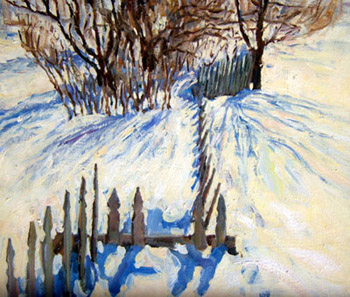 |
Ron Arthaud "Buried" oil on canvas "14" x "16" 2005 |
Great Basin Gallery
20th Anniversary Exhibition
. . .
Curators’ notes: In conjunction with “Great Basin 20th Anniversary Exhibition” the Capital City Arts Initiative commissioned an essay by nationally distinguished arts writer William L. "Bill" Fox. He had three books out this fall. TERRA ANTARCTICA (Trinity University Press) is a history of the visual represention of the continent; IN THE DESERT OF DESIRE (University of Nevada Press) looks at how art, animals, and sex are presented on the Las Vegas Strip; and, DESERT WATER (Graphic Arts Center), a book of nature photographs by Idahoan Mark Lisk featuing Bill's text. Our heartfelt thanks go to Mr. Fox for his invaluable participation in the exhibition.
The Great Basin Gallery, which is located inside a modest single-story frame house just off the main thoroughfare in Carson City, sits at the boundary between commercial and residential districts. You can, if you wish, take its location as symbolizing a way of bringing together that which you cannot purchase—a sense of place—and that which you can, a painting that helps create a sense of place.
The gallery specializes in the kind of art that co-owner Jeff Nicholson himself practices, which is to say paintings made directly from the landscapes of the Great Basin, that highest and coldest and largest of North American deserts. It is a daunting terrain in which to work, its arid mountains and basins holding fewer species of plants than the Mojave, Sonoran and Chihuahuan deserts to the south. It is by virtue of these austerities, however, than one is able to see more clearly the bones of the planet than elsewhere, a situation that rewards the patient observer, most especially those painters willing to work at least part of the time outside the studio.
This brings us to a complicated question: Of what virtue in an age of photography is landscape painting in general, and painting done en plein air in particular? To answer it, perform an experiment. Go to your living room window and take a photograph through it of the view outside. Make a print of the photo, then go outside with it in hand. Stand with your back to the window and compare what you see in your hand with what is in front of you.
The photograph is all about a fixed pattern, your eye moving over a single surface and assembling a picture of the world based on the contrasts between light and dark, the consequent shapes, and differences in color. Taking a picture through a window reminds you that your view through a camera is framed in a rectangle and flattened by a two-dimensional plane of glass. The view in front of you when you are outside, by contrast, makes your eyes move not just across the landscape, but in and out of it. You are literally more actively involved in what you are seeing.
There is also the peculiar fact that things in the background of the photo looks smaller than they appear when you are outside, a distortion so distracting that, when photographs were first invented, people had trouble understanding how to interpret them. They thought the camera was lying. It wasn’t, but neither was it able to mimic how the mind processes the world, where some things appear more important than others, no matter their distance, hence larger in our imagination.